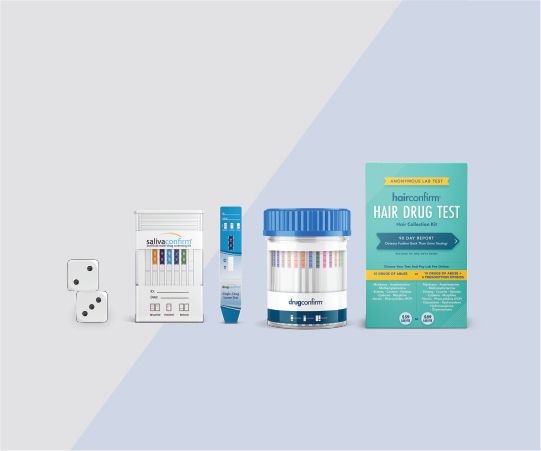How to Read a Drug Test Cup

Drug test cups are a very popular method of drug testing. Urine drug test is often used for pre-employment screening, compliance assessment, and home substance abuse prevention. If you have opted for a 5-panel, 10-panel, or 12-panel drug test, here are the most important things to know about this drug test method.
Reading a Drug Test
After you have selected the appropriate urine screening cup, you can begin with testing and interpretation of results. Collecting and interpreting specimens involves following the appropriate steps to accurately determine the result of the test. This involves being familiar with the components of the test and how to interpret each one.
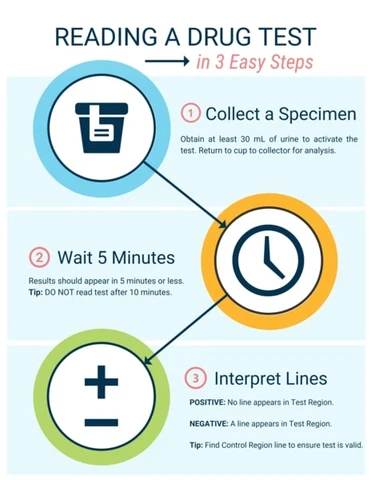
1. Locate Control and Test Regions
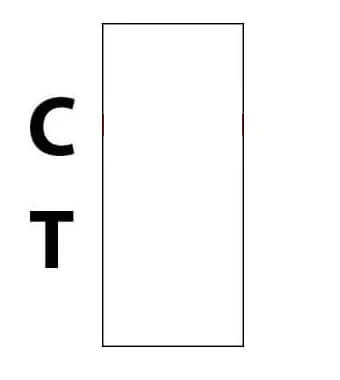
Each panel will have its own Control Region (C) marked at the top, and a Test Region (T) specific to the drug being tested. The Control Region indicates that the test is working properly and the Test Region indicates whether the drug you are testing for is present.
After obtaining a sample, a line should appear next to the control region, or the C mark. If the Control line does not appear after 10 minutes of obtaining a sample, discard the test and administer a new one.
2. Obtain a Sample
Most people will opt for a multi-drug screen kit like the 12 Panel DrugConfirm Advanced Flat Panel Urine Drug Test Cup with Adulterants. A multi-drug test kit can save time because it detects several substances at once. The person being tested must urinate into the sample cup to the appropriate volume needed for testing. A specimen that is too little may not yield accurate results.
3. Wait 5 Minutes
A major benefit of Instant urine drug tests (i.e. cups and dip cards), as well as mouth swab drug tests, is that they are designed to yield results just a few minutes after a specimen (urine) collection. Tip: Do not read drug test results more than 10 minutes after a sample is collected. After 10 minutes, drug test results may not be accurate.
4. Identify Colored Lines
Negative Drug Test Results
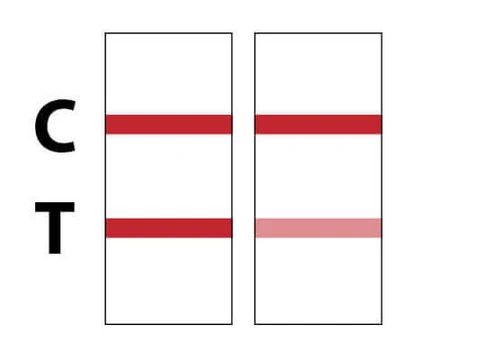
If a colored line appears next to both the Control Region and Test Region (as shown above), the result is NEGATIVE. A negative result means the drug, or drugs, in question were not detected. The color intensity (faintness or darkness) of the line is not a factor when assessing results. A faint line DOES NOT mean the specimen contains small amounts of a specific drug metabolite.
Positive Drug Test Results
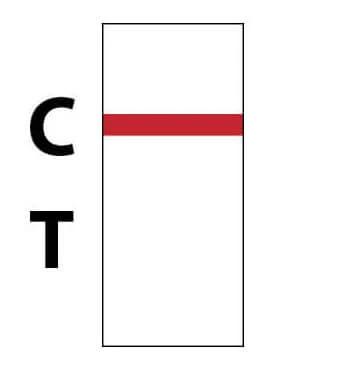
When no line appears in the Test Region (T) but a colored line is displayed in the Control Region (C), the drug test result is POSITIVE. A positive urine test result indicates that the drug, or drugs, in question were detected by the drug test. The positive drug test result might be the start of action against an employee, parolee, student, etc. who abuses illicit substances.
Before a positive result can be ascertained, check to be sure the Control Region (C) is marked with a colored line to indicate the test is valid and non-defective. If there is no colored line marking the Control Region (C), the test is not valid, and the test result may not be accurate.
NOTE: Instant immunoassays are only used for preliminary screening. If a preliminary screening test is positive, the positive test results obtained through instant drug tests should be sent to a SAMHSA-Certified laboratory site for confirmation.
How to Read a Temperature Strip on a Drug Test
A urine test cup usually contains a temperature strip, which is built in to detect abnormalities in the specimen. Temperature strips for urine testing can also be applied separately by a Third Party Collector (TPA).
An acceptable urine temperature for drug test analysis falls between the range of 32–38 °C (90–100 °F). If the drug test temperature is out of range, it is possible the urine is adulterated by substances (i.e. water) indicating the drug test has been falsified. Again, a TPA will have the greatest understanding of drug test results.
How Can Sample Adulteration Be Prevented
To prevent sample adulteration it is important ot maintain tight control on the collection process. Tight control of the collection process can help protect against adulteration and prevent individuals from falsifying their drug tests. Other ways to prevent falsified urine samples:
- Ask donors to place personal items in a secure box outside of the testing area. This prevents donors from bringing in bags or items containing urine that is not their own, or liquid to dilute the contaminated urine.
- Random drug screening may be the truest strategy to detect substance abuse. Avoid scheduled announcements if congruent with your workplace drug test policy. Random drug screening provides little time for donors who are using drugs to eliminate them from their system. While some drugs stay in the body for long periods of time, others that are eliminated quickly may best be identified with random drug testing.
- Monitor collection site check-in times. A long bathroom delay might signal a donor's attempt to cheat the drug test.
- Inspect restroom for potential adulterants, e.g soaps and cleaning powders.
- Consider on-site collection if possible. On-site collection in a tightly-controlled environment reduces the donor’s ability to use different substances, or urine that is not their own, to falsify the drug test results.
Importance of Urine’s Temperature
Medical staff will often measure the temperature of urine samples that are submitted to them. The appearance of a sample specimen is not nearly enough to verify that the sample submitted is authentic and unadulterated. Though the sample may look authentic, donor’s potentially could have used another persons urine that they snuck into the testing facility. The appearance of the sample may also not indicate whether the donor put soap, water, or other substances into the specimen to create an invalid result. Therefore, the medical staff makes use of an adulterant test using temperature to determine if the samples have been tampered with.
Even when using adulterant tests to determine authenticity, no one can be certain if the sample was merely a “good-quality” fake urine or was obtained from another person. Measuring the temperature is an effective way to verify that the sample came from the person being tested.
When obtained fresh, human urine is typically at 94-96°F. However, the temperature may change as soon as it is exposed to either warm or cool environment. For drug screening, a urine temperature that is within the range of 90-100°F is usually acceptable. Ensuring that the sample is in this temperature range is the best way to tell whether the sample actually came from the donor at the time of testing. If the specimen temperatures go lower or higher than this range, the urine test was likely tampered with or contaminated. If this is the case, the sample will be rejected and the donor may be subject to consequences and another drug test.
Thermometer Reading Instructions
Urine drug test cups often have a standard thermometer strip has color-based indicators to determine the temperature of the urine sample. Although this kind of product may come in different models and forms, most of them follow this standard set of instructions:
- As soon as the urine sample is placed in the cup, wait for the green indicator depicting the temperature of the specimen.
- If the color that you see is blue, add 1 degree Fahrenheit or 0.5 degree Celsius from where the indicator lights up. If you see a tan or brown color, subtract 1 degree Fahrenheit or 0.5 degree Celsius from the temperature mark.
The best way to ensure that you’re using the product correctly is to read the instructions manual that comes together with the kit. Using the product correctly and reading the results correctly is important to yield accurate and unadulterated fesults.
As a precautionary measure, keep the cup away from direct exposure to sunlight or temperatures beyond 55 degrees Celsius.
As stated above, the normal temperature of human urine ranges from 94°F to 96°F (about 35°C). For the most accurate results, the temperature of a drug test sample should be read during the first 4 minutes after it was received, as the sample temperature may change depending on the ambient environment.
Acceptable temperature range is from 90°F to 100°F (32°C - 38°C). Any sample with a temperature outside this range should be deemed suspicious and should be checked for any adulteration.
How To Use Urine Drug Test Cup with Thermometer Strip
Urine drug test cups with thermometers are great tools and often read the sample’s temperature in Celsius or Fahrenheit. A newly collected urine sample should be warm to the touch, but a more accurate temperature is necessary to ensure that it has not been adulterated. Using the thermometer strip allows you to check whether the sample is obtained fresh or adulterated.
The following is a step-by-step procedure on how to accurately and effectively collect the sample in a urine drug test cup with a thermometer strip:
- Collect a urine sample of at least 30 mL. A volume less than 30mL is not an adequate amount for accurate testing.
- Check the temperature of the sample (see Thermometer Reading Instructions above)
- Pour the specimen into a bottle that is sealed with tamper-evident tape. Tamper-evident tape is useful to ensure that the sample has not been adulterated before arriving at the laboratory.
- Send the specimen and completed Custody and Control Form (CCF) to the laboratory for testing
- Ensure that the container is labeled properly. The container must be labeled properly to guarantee the sample is documented correctly.
Urine Drug Testing
Drug tests are used to determine the presence of illicit drugs and involve the use of bodily fluids for testing. Urine drug testing is the most commonly used type of drug test. The benefits of using urine drug test include the following:
- It is the least expensive of the test methods.
- It is considered a non-intrusive method of testing.
- It can be used at home (for example by parents), although it requires lab verification for accurate results.
- It can detect use primarily within the past week (longer with regular use).
Urine samples are often temperature-tested to ensure sample integrity.
Urine Specimen Collection
Typically, the specimen collection for urine drug test is performed on-site when so requested such as by the employer or school administrator. It may also be done at the laboratory where the laboratory technicians or medical staff read the results. However, there are some urine drug test products available which allow home testing or instant reading of the results on-site.
Specimen collection should be done under tight supervision. Steps should be taken to avoid the possibility of any adulteration to the sample.
Drug Test Cups
Drug test cups are used to test urine samples for many different drugs that are commonly abused. Drug test cups are often preferred because they are inexpensive, easy to use, and provide test results within a short amount of time. Test strips or test cards come with these cups and are dipped over the sample for the reading of results.
There are different choices when it comes to drug test cups. Among them are those that come from different brands like:
DrugCheck NxStep
This brand launched its very own Onsite Urinalysis Test Cup that can be used easily in the detection of onsite drugs. It makes use of a testing device with its collection cup to detect the presence of various drug metabolites in a matter of minutes. It can test up to 15 drugs and adulterants such as amphetamine (AMP), buprenorphine, cocaine (COC), meth, opiates, phencyclidine and TCA to barbiturate, benzodiazepine (BZO), MDMA/Ecstasy, methadone, oxycodone, propoxyphene and marijuana/cannabis.
T-Cup
This is a convenient, one-step drug test cup. It specifically helps in detecting elevated levels of certain types of drugs and their presence in urine. It is FDA-approved and comes with a security strip that guards against possibilities of specimen adulteration. It comes with a wide-mouth cup opening that makes specimen collection easier and less messy.
E-Z Split Key Cup
This brand offers an integrated urine drug test kit that can be used either by employers, pain centers, clinics and other health centers. This FDA cleared drug test cup is ideal for the needs of many professional organizations and can be used for testing drugs of abuse like antidepressants, benzodiazepines, methadone, oxycodone and propoxyphene.
DrugConfirm Advanced Drug Test Cup
This is the brand that is best suited for home drug test. DrugConfirm is a proven drug abuse prevention tool that is both convenient and confidential for the end user. This is CLIA Waived and FDA Approved. Providing results in minutes, the kit comes with a specimen transport box and a specimen ID card. It can be used to test drugs like cocaine, marijuana, amphetamines, methamphetamines, opiates and phencyclidine.
iCup Drug Test
This FDA cleared drug test cup is manufactured by Alere Toxicology and offers a wide range of integrated test cups for multi-drug screening. The iCup urine test come in a variety of configurations and offer the ability to detect anywhere from 3 to 13 drugs of abuse in one test. These test cups also come with the option of detecting up to 6 adulterants in one test, helping to all but eliminate urine specimen tampering.
Instant results populate in under 5 minutes and provide up to 99% accuracy while the flat sided results panel makes for ease of photocopying drug test results.
Advantages of Using Urine Cups
Urine drug tests are convenient and affordable. Key features include:
- Various sizes, with graduations in ounces (oz) and milliliter (mL)
- Wide clean-catch brim with screw-on cap
- Rapid results
- Temperature strips
Drug test cups can be used in many different settings. Some examples include:
- Criminal Justice
- Home Drug Testing
- Law Enforcement
- Rehabilitation Centers
- Workplace, Staffing, and Recruiting
- School Protection
Choosing a Urine Test Cup
Urine drug tests can detect many illicit substances, including but not limited to:
- Prescription opiates
- Marijuana (THC)
- Cocaine (COC)
- Amphetamines (AMP)
- Ecstasy (MDMA)
- Synthetic drugs
- Etc.
Some urine test cups are able to detect multiple substances at once, while some are specific for certain drugs. Choosing the right urine test cup for your purposes depends on why you are drug testing and what you are testing for.
There are two basic types of urine drug testing:
Urine Screening Test
This type of test uses immunoassay to find the parent drug and/or metabolite. Immunoassay means the test looks for certain substances and molecules to provide a positive or negative result. Most common drugs screened include cocaine, amphetamines, opiates, marijuana, PCP, methadone, and benzodiazepines (BZO). A urine screening test is fast, but may not be the most reliable result. If a urine screening test is positive, it should always be confirmed using a more specific urine confirmatory test.
Urine Confirmatory Test
This type of urine drug test undergoes gas chromatography/mass spectrometry (GC/MS) or high-performance liquid chromatography (HPLC) testing in a laboratory setting. This test is much more specific than a urine screening test and results are very accurate. This type of urine screening is used in testing for the presence of a specific drug, especially when the initial screening test produces a positive result.
Urine Collection Cup Features
An ideal urine collection cup should have the following specifications:
- It should be sterilized. Bacteria can affect the results of a urine test or render the result invalid. Sterilization also prevents other types of contamination and provides the most accurate results.
- It should hold at least 90 mL of urine. While tests often only need about 30 mL for an accurate read, a large receptacle is necessary for the donor’s ease of use and in case multiple tests are being done.
- There should be a tamper tab to determine if the sample has been contaminated or adulterated. Tamper-evident tabs help indicate if a sample has been adulterated. If the tamper-evident tabs are positive, the sample is invalid and should be repeated.
- The container should be ideal for harsh transport conditions (i.e. does not easily break). This ensures the integrity of the sample during transport to the lab.
- The container must be made of a clear, high-quality polypropylene plastic to keep the sample in great condition even under pressure. It is important to keep the sample in optimal condition to yield an accurate result.
- The cap of the urine collection cup should prevent threading and leaking.
- Containers should be graduated from the inside. This should be in both ounces and milliliters. This helps guarantee that the volume of the sample collected is enough to read a result.
Urine drug tests may come in different forms, such as urine drug cassettes and urine drug test dip cards. The Sterile Urine Collection Cup with Temperature Strip may be the best diagnostic aid for you. It ensures that you collect the appropriate volume of urine, provides rapid results, and contains a temperature strip to confirm that the sample has not been tampered with.
This urine collection cup is designed to provide a convenient way of collecting urine samples. This urine collection cup has a secure screw that prevents specimen leakage and possible contamination. Apart from having a wide-mouthed sterile cup, each sterile cup has a temperature strip to protect from urine contamination. The sterile cup has a maximum capacity of 90 mL, enough to be used for testing. These features make this an optimal urine testing cup that will yield accurate test results.
How Urine Drug Testing Is Performed
A 30 mL midstream urine sample is needed to conduct a standard urine drug test like the 10 Panel T-Cup CLIA Waived Urine Drug Test Cup. The specimen is collected in the privacy of a restroom. A urine testing cup that reaches up to 90mL is preferred for testing for ease of use for the donor and to collect extra urine if extra tests are to be performed.
The collector then pours the sample from the urine testing cup into the specimen container. This prevents the donor from contaminating the final sample.
A positive or negative test result will appear on the indicated panels within 5 to 10 minutes. Any preliminary positive tests should be sent to an accredited laboratory for further analysis for confirmation of results. A urine confirmatory test will be executed to be certain of the kind of drug present in the sample. This confirmation is necessary to verify the results from the initial rapid urine test.
Urine Drug Screening Detection Times
Each individual’s body reacts differently to different drugs. Some drugs stay in the donor’s system for a long period of time (weeks to months), while other drugs are only in the system for a very short amount of time (hours to days). Urine drug tests can typically detect the drug in question immediately after use. Some collection cups are also more sensitive than others, providing early or extended detection windows.
New Column New Column New Column New Column
Substance
Detection Period
Substance
Detection Period
Amphetamines
2-5 days
Barbituates (Short-Acting)
2 days
Barbituates (Long-Acting)
3-4 weeks
Benzodiazepines
7-10 days
Cannabinoids (THC, Marijuana)
5-60 days
Clenbuterol
4-6 days
Cocaine (COC)
1-4 days
Codeine
5-7 days
Euphorics (Ecstasy, Shrooms)
5-7 days
Ketamine (Special K)
5-7 days
LSD (Lysergic Acid)
7-10 days
Methamphetamines
5-7 days
Steroids (anabolic oral)
14-28 days
Opiates
5-7 days
Steroids (anabolic parenterally)
1-3 months
Phencyclidine (PCP)
2-4 days
Phenobarbital
10-20 days
Propoxyphene
6 hours to 2 days
Urine drug screening is very effective in detecting recent use, typically in the past 1-3 days. Urine drug screening is appropriate for any testing reasons and can be used for a wide range of illegal substances and prescription drugs.
Prescription Medications, Supplements, and Urine Drug Screening
It is important that for individuals scheduled to undergo a urine drug test to disclose their full medical history, including all prescription medications, over-the-counter medications, supplements, diet supplements, or herbal medications that are taken (such as herbal supplements and over-the-counter medications) since some of these substances may contain substances that can affect a drug screen. For example, urine drug tests often test for amphetamines and opioids. A Urine drug test will not differentiate between prescription medications and illicit substances. Many donor’s may have a legitimate prescription for opioid pain medication from their doctor. Similarly, some diet pills and ADHD medication can contain amphetamines and methamphetamines. It is important to identify a donor’s full medication and supplement history to differentiate between abuse and legitimate prescription use.
Urine Adulterants
One of the major challenges in urine drug screening is the illegal practice of manipulating the specimens to produce a false negative result. Drug users consider masking their urine samples to avoid being caught.
A major challenge in urine drug screening is the illegal practice of manipulating the urine specimen to produce a false negative result. Donors who use drugs often try to mask the drug in their urine samples to avoid a positive result. Donors try to use a variety of different substances to invalidate their urine sample or cause a negative result.
Some of the common substances that people use to tamper with urine specimen include hypochlorite bleach, table salt, toilet bowl cleaner, laundry detergent, glutaraldehyde, potassium nitrate, and pyridinium chlorochromate. Adding these chemicals may invalidate a drug test result. However, the addition of these chemicals may affect the temperature of the urine sample which is why a temperature strip is so useful in identifying urine drug screening.
In addition to the temperature strip, drug screening laboratories are more readily able to detect adulterants in urine samples.
- Creatine: It is a natural byproduct of the body’s muscle tissues and should be present in a normal system. A urine sample with low levels of creatine may indicate that the sample was the result of water flushing or “detox” approach.
- Glutaraldehyde: It is a known adulterant that causes false negative results by tampering with the naturally occurring enzymes in urine. Since glutaraldehyde is not naturally present in human urine, the detection of glutaraldehyde is a likely result of tampering with a urine sample.
- Nitrite: The presence of this compound is a clear indication of sample manipulation since nitrite should not be present in human urine at all.
- Specific gravity. This parameter describes the normal levels of dilution present in the sample. If the sample does not fall within the normal ranges of dilution – generally 1.003 to 1.030 – then it might be possible that the sample was artificially diluted by an adulterant.
- PCC/Oxidants: Presence of this compound come in the form of traces of bleach or peroxide in samples. Since normal urine should not contain any traces of oxidants, finding these traces typically points to an adulterated sample.
- pH: The normal pH of human urine is between 4.0 and 9.0. Any reading that is outside of this range is an indication that the sample may have been manipulated.
It is for these reasons that temperature strips have become very helpful in determining if the urine sample is contaminated or tampered.
Final Word
Urine drug screening is useful for drug testing in many different settings. Different urine drug tests are able to detect many different illicit substances to meet your needs. Urine drug screening provides rapid, accurate drug test results. As long as the tests are performed according to the instructions and interpreted accurately, the result from the screening can be further confirmed by a laboratory to verify the results. To ensure that drug test results are always accurate, make sure to only use sterile urine collection cups to avoid having false negative or false positive results.

